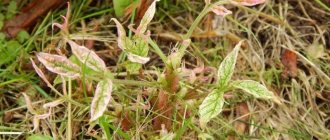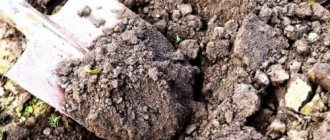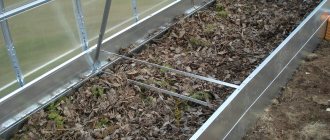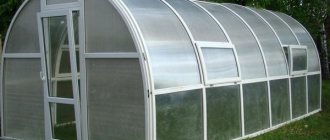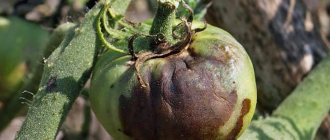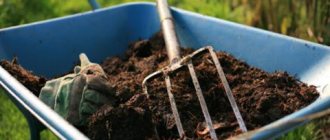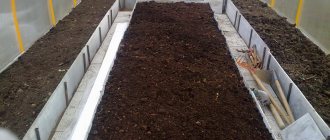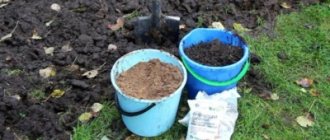To have less hassle in the spring when preparing the greenhouse for planting, devote more of your time to it now. All season long, not only cultivated plants grew in the greenhouse, but also “freeloaders” - pathogenic micro- and macroorganisms. Eggs, larvae, and spores of various pests and diseases, resistant to low temperatures, accumulate both on the walls of the greenhouse itself and in the upper soil layer. To get rid of them and possible problems in the spring, you should carry out autumn treatment of the soil and the walls of the greenhouse inside and out. Even novice gardeners can independently restore order in their film-plastic farming and prepare their greenhouses for the next season.
Why is soil tillage needed?
I never forget about the autumn and spring cultivation of greenhouse soil; I consider this an important and necessary agrotechnical measure. As far as I know, not all gardeners share the same opinion - and very wrongly. Spores of infectious agents, eggs and larvae of pests overwinter well in a greenhouse and are “inherited” to future plantings.
High-quality and consistent processing successfully prevents this:
- Prevention of late blight.
- Fighting fungus and mold.
- Minimizing the risk of fungal and bacterial infections.
- Destruction of remaining pests, their larvae and eggs.
- Timely autumn treatment of the greenhouse reduces the amount of work in the spring - all you have to do is complete preventive measures.
Another benefit of autumn-spring tillage is improving the fertile qualities of greenhouse soil. Due to the limited space, nitrogen, phosphorus, potassium, and microelements necessary for planting are quickly washed out of it. Ideally, after the season, the top layer of greenhouse substrate is removed and replaced with fresh, fertile and uninfected one. But complex cultivation of the land helps me resort to this labor-intensive procedure only once every five years. I act like this:
- I remove the top layer of earth - 10-15 cm.
- I dig up the remaining greenhouse soil, manually removing plant debris, eggs and pest larvae.
- I plant the space with green manure, then mow them, and incorporate useful greens into the soil.
- I disinfect fresh soil either with chemicals (potassium permanganate, Bordeaux mixture) or with biological preparations (Fitosporin, Siyanie), after which I scatter it evenly over the greenhouse ridge.
Disinfection of greenhouse walls and structures in the fall
Now you can begin preparing the walls of the greenhouse. It is recommended to treat the walls in the greenhouse after the first soil preparation.
Disinfection of a polycarbonate greenhouse in the fall is one of the most important activities. Cucumbers, peppers and tomatoes are most often grown in a greenhouse, which can suffer from various diseases in greenhouse conditions. There are a lot of means to get rid of pathogenic microflora.
Many summer residents disinfect the entire greenhouse with a solution of potassium permanganate. Potassium permanganate can kill many parasites.
How else can you disinfect a greenhouse in the fall? Soda, formaldehyde (250 g per bucket of water), and 5% copper sulfate will cope with this task.
Watch this video in which Ivan Russkikh tells how to treat a greenhouse in the fall after finishing the tomato, pepper and cucumber crops. There is one inexpensive remedy available to everyone, which has proven to be the most effective for disinfecting a greenhouse from diseases.
Ivan Russkikh is a popular video blogger, expert of the Youtube channel “Procvetok” and the channel “Ivanova Science”. Researcher, teacher, head of the Research Laboratory of the Russian Center for Economics and Culture, member of international scientific communities.
The best solution for sanitizing walls is a white solution (hypochlorite). Prepare a solution: pour 1 liter of chlorine bleach White (the composition should contain sodium hypochlorite 25-30%) into 10 liters of water.
Within an hour after preparing the solution, spray the greenhouse with a sprayer. After a week, you can rinse the greenhouse with a sprayer with clean water.
You can also use chlorine-free peroxide bleaches, for example, Bos, Persol, Vanish, which contain perborates. We dilute the bleach as indicated in the instructions for bleaching laundry. The water should be hot, at least 60-70 degrees. We treat all surfaces of the greenhouse with a sprayer.
When using chemicals in a greenhouse, be sure to protect yourself from chemical fumes and splashes. Prepare protective items: respirators, aprons, goggles, rubber gloves. After treatment, immediately leave the greenhouse and wash yourself. And in the greenhouse itself, open the windows and doors to ventilate it.
When spring comes, your greenhouse will be clean, free of pests, mildew and mold. In addition, a clean, washed and treated structure will last longer.
Methods for cultivating soil in a greenhouse
Depending on the drugs I have and free time, I choose one of the methods of spring-autumn processing of greenhouse soil. I advise you to alternate them from year to year so that pests and pathogens do not have time to develop immunity.
cultivation of soil in a greenhouse
Biological
For lovers of new products, I recommend modern biological disinfectants. These are harmless substances for both humans and plantings that do not accumulate in the substrate, but at the same time have a long period of influence. All you have to do is prepare the solution and pour it evenly over the greenhouse soil:
- "Trichodermin": per 10 liters of water - 100 ml.
- “Alirin-B”: 1 tablet per 10 liters of water.
- “Fitosporin”: per 10 liters of water - 6 ml.
- “Baikal-EM”: for 10 liters of water - ½ cup.
Biological agents also include folk ones - disinfectant solutions made with ash, mustard, pine needles or tobacco. I load ⅓ of the bucket with raw materials, and add water to the rest. I leave it for several days and dilute it with water in a ratio of 1:3. But I will warn you that such folk remedies are good as additional, preventive, and not basic ones.
Another interesting method of biological treatment is planting green manure. These plants heal the soil, saturate it with nitrogen, draw potassium salts to the surface, and can be used as vermicompost. There is a very wide choice here:
- Legumes: vetch, peas, phacelia, lupine.
- Cereals: wheat, oats, barley, rye.
- Cruciferous and Compositae: mustard, radish, sunflower.
During autumn biological treatment, I give preference to frost-resistant and early-ripening varieties of green manure: rapeseed, fodder peas, vetch, mustard, oats.
Chemical
I’ll tell you about popular chemical preparations that have earned the trust of gardeners:
- Formalin: per 100 liters of water - 1 liter.
- Copper sulfate: per 10 liters of water - 1 tbsp. spoon.
- Potassium permanganate: per 1 liter of water - 1 teaspoon.
- Chloride of lime: per 10 liters of water - 400 g.
It is not difficult to work with the resulting solutions - evenly pour the liquid over the entire greenhouse soil.
Use alternative chemical methods:
- Lime chloride. Mix the dry substance with the soil: per 1 m2 - 200 g of the drug.
- The first method of using 40% formaldehyde: dilute 1 liter of the product in 50 liters of water. To treat a square meter of land - 10 liters of the resulting solution. Collect wet soil, take it to an open place, where it dries in the sun for 2-3 days. After this, return the soil to the greenhouse and distribute it evenly over the ridges. Remember that you can only work with formaldehyde in a respirator.
- The second method of using 40% formaldehyde: use the solution prepared according to the previous instructions. Make small grooves around the entire perimeter of the greenhouse and pour liquid into them. Be careful: formaldehyde vapors are poisonous to humans - you can be poisoned unnoticed and quickly.
Another popular and inexpensive chemical treatment method is the use of sulfur bombs. Acrid smoke easily penetrates into the smallest crevices that a person with a brush cannot reach. The method is simple and effective, but requires caution. Be sure to follow the instructions strictly! The smoke released is very toxic to humans - most dangerous to the respiratory tract. A sulfur bomb is not suitable for treating greenhouses with unpainted metal parts, as it contributes to their corrosion.
This drug resembles a large tablet with a wick for lighting. The number of sulfur bombs used is determined based on the volume of the greenhouse: 1 piece per 5 m3. The tablets are placed on non-flammable stands throughout the greenhouse. Light the wick, then close all doors and vents tightly for 2-3 days. After this treatment, be sure to thoroughly ventilate the greenhouse and wash the inside of the structure with soapy water.
Thermal
Another effective processing method is steaming. I do it like this:
- I pour boiling water over the beds: 10-15 liters of water for every 1 m2 will be enough. Some gardeners do not use ordinary water, but a 3% solution of potassium permanganate or nitrafen.
- I quickly cover the hot earth with thick polyethylene.
- I leave the film on for 1-2 days.
- I apply fertilizers at least 3 weeks after treatment.
To ensure that steaming destroys all pathogens and pests, I repeat it 2-3 times.
An alternative to steaming is heating the greenhouse substrate with infrared lamps. If you have a small greenhouse, it will be easier to remove the top layer of the substrate, immerse it in a vat or iron basin, fill it with water and steam the soil over a fire.
There is also the exact opposite method - freezing:
- Visit the garden in winter, open the doors and vents of the greenhouse. To prevent the greenhouse from being completely covered with snow, it is better to withstand only 5-6 days of such treatment.
- If you have a small greenhouse, collect the top layers of soil in bags in advance and take them out into the open. In winter, bring it back into a warm room - warm it up for about a week, and then send it out into the cold again.
Useful tips
Some useful tips:
- If you have a polycarbonate greenhouse, open all the windows and doors in it in late autumn. This will avoid the formation of ice.
- To strengthen the polycarbonate structure, you can use T-shaped wooden supports. Then the structure is unlikely to collapse under the weight of snow.
- It is advisable to regularly replace the soil in the greenhouse, at least the top layer.
- It is undesirable to leave foreign objects in the greenhouse over the winter so as not to spread pathogenic microorganisms.
You will be interested to learn about pests and diseases of tomatoes in a greenhouse, as well as methods for controlling pests of peppers in a greenhouse.
As you can see, preparing a greenhouse for winter is simple. First, the soil is cleared of debris, then disinfected, and finally the structure is strengthened. All these procedures will allow you to spend less time on pest control when growing crops. The main thing: do everything on time.
What and how to treat the land from diseases and pests
I will tell you about the correct use of popular means for treating greenhouse soil, which will help achieve their maximum effectiveness.
Fitosporin
One of the most recognized and popular biological products among gardeners is Fitosporin. I appreciate it for its low cost and high efficiency. The drug has a complex effect on organic soil inclusions: organic matter decomposes, having a negative effect on harmful microorganisms living in the soil. The advantage of “Fitosporin” is that it does not destroy beneficial microflora and saturates the substrate with microelements necessary for plant development.
As for disinfection, I dilute Fitosporin-M at the rate of 100 g per 10 liters. I treat the soil twice, waiting an interval of 2 weeks. Be sure to use settled water, or better yet, rain, melt or well water: chlorinated water reduces the effectiveness of the drug.
processing the garden using Fitosporin-M
Potassium permangantsovka
The use of potassium permanganate solution for soil disinfection is typical for both gardening and indoor floriculture. It’s easy to work with the product - dilute a 1% solution. The result will be a pale pink liquid. Sprinkle it evenly over the soil. Use the same solution to disinfect glass, film and polycarbonate parts of the greenhouse.
potassium permanganate
Copper sulfate
I value this traditional garden remedy for its effectiveness in controlling cladosporiosis, late blight and powdery mildew. It is difficult to overestimate its properties:
- good antiseptic;
- suppression of the development of insect pests;
- remedy for mold, rot, fungus;
- replenishment of the microelement copper in the soil.
To achieve greater efficiency, I recommend using only fresh vitriol solution. Be sure to mix it in a metal container, otherwise the iron and copper sulfate will react with each other.
Using this substance is very simple:
- For 10 liters of water - 100 g of copper sulfate + a little freshly slaked lime. Treat the greenhouse soil - this method is used no more often than once every 5 years.
- Add a little crushed household soap shavings to the prepared solution - the resulting product is used to treat the covering material and greenhouse structures. I spray the liquid from a spray bottle and then clean the surface with a brush.
Remember that copper sulfate is a moderately toxic drug, which is why you need to wear thick gloves and a respirator when working with it.
How to till the soil before planting tomatoes
If you grew tomatoes in a greenhouse last season, and even more so if the tomatoes were affected by late blight, the greenhouse substrate requires special treatment in addition to disinfecting the soil:
- Remove the top layer of soil, replace it with fresh - uninfected and fertile.
- Plant green manure - alfalfa, mustard, oats, rye. These plants help disinfect the soil, saturate it with nitrogen, loosen and soften the soil.
- To make the substrate loose and breathable, sift it through a sieve and add humus or vermicompost.
- If necessary, do deoxidation in the fall: per 1 m2 - 500 g of lime.
garden cultivation
I practice crop rotation in greenhouses as much as possible. One year I plant tomatoes, another - cucumbers. If after the tomatoes it’s the pumpkin’s turn, I carry out another treatment:
- I replace the top layer of soil with fresh black soil.
- I add a bucket of rotted manure for every 1 m2.
- I disinfect the removed soil and mix it with humus or compost approximately 1:1.
- In the fall, before frost, I plant greenhouse beds with green manure - oats, peas, phacelia, rapeseed.
- In winter, I go to the garden and cover the greenhouse soil with snow: this not only promotes freezing, but also provides sufficient moisture in the spring.
- If necessary, I deoxidize the soil: per 1 m2 - 200 g of lime, 300 g of dolomite or 350 g of ash.
Fertilizing the soil for the winter
After disinfection work, it is necessary to fertilize the soil. Both organic and mineral complexes are applicable. Organic matter improves the structure of the soil, making it loose, air- and moisture-permeable, and also saturates it with necessary elements. Manure, compost, humus, and peat are suitable as organic matter.
Mineral complexes:
- superphosphate (20 g per bucket of water, leave for 3 days);
- urea or saltpeter (25 g/1 m²);
- potassium sulfate or chloride (20 g/1 m²).
All fertilizers are applied once, no later than mid-October.
Autumn cleaning in the greenhouse
In the fall, I’m not lazy to do some general cleaning in the greenhouse:
- I clean, disinfect and take trellises, pegs, pins, and supports into the utility room for storage. I collect and burn old garter material.
- I wash, repair garden tools and hoses if necessary, and take them out for storage.
- I remove plant debris, collect visible eggs and insect larvae, and then burn this “wealth.”
- I dig up the greenhouse substrate, collect roots, plant remains, and larvae with a fan rake.
- I sweep the paths, wash them under powerful pressure.
- In good weather I carry out ventilation.
greenhouse treatment
Why treat a greenhouse in the fall?
The greenhouse and the soil in it after harvesting can be infected with pathogenic microorganisms, fungi and various pests. All sorts of preventive measures will help get rid of them.
Experienced vegetable growers know that fungus, mold, and insect larvae that have overwintered in a greenhouse will be difficult to attack new seedlings in the spring and will be difficult to fight. For example, a whitefly can be destroyed when it is in the larval stage, since the adult is not afraid of even strong chemicals.
Therefore, it is better to disinfect the greenhouse and soil in the fall than to lose the future harvest due to pest attacks.
Processing of greenhouse structures
Tilling the land alone is not enough to completely protect future plantings from pests and infections. There are probably cracks and holes in the frame of the greenhouse itself where uninvited guests can safely spend the winter.
Here's what I do here:
- I wash the walls inside and out with a solution of laundry soap shavings. I do not recommend aggressive detergents - their use will reduce the light transmission characteristics of the same polycarbonate.
- I remove the film, clean it and wash it separately. I dry it, then put it in the utility room for storage - I only pull it onto the frame in the spring.
- In a greenhouse made of polycarbonate or glass materials, I advise you to use brushes and sponges with long handles, which are easy to clean hard-to-reach areas. Iron sponges and abrasive sponges are not suitable - they scratch the material, causing it to become cloudy.
- I treat wooden parts with antiseptics, and iron parts with an anti-corrosion agent. For disinfection - a solution of bleach (per 10 liters of water - 400 g) or copper sulfate (per 10 liters of water - 100 g).
I will share recipes for good solutions for cleaning greenhouses:
- Soap: shavings of one bar of household soap per 10 liters of water. Simply apply the solution to contaminated surfaces for 5-10 minutes, then rinse with clean water.
- A solution of baking soda and dish cleaning products.
- Formalin solution: per 10 liters of water - 250 g.
- Bleach solution: per 10 liters of water - 400 g.
- Moss and lichen solution: 5% copper sulfate concentrate.
Preparing the greenhouse for disinfection
After the last vegetables growing in the greenhouse have been harvested, you must:
- remove all garden tools from the building, dismantle old trellises, collect and dispose of strings used for tying bushes;
- carefully select all the roots from the ground, rake tops, leaves and other plant debris into a pile, pack them in large bags, take them outside the garden and burn them;
- wash the transparent parts of the greenhouse with soapy water, rinse off the foam with water flowing under high pressure from a garden hose with a shower head, wipe the glass or polycarbonate sheets with a sponge soaked in a bright purple solution of potassium permanganate;
- wash the metal pipes of the frame with a concentrated solution of copper sulfate, whiten the wooden parts of the structure with lime;
- use a rake to break up all the clods of earth on the ridges, loosen well and thoroughly level the soil.
Advice. A product that perfectly disinfects not only the soil, but also the greenhouse structure itself, is the toxic smoke emitted by a smoldering sulfur bomb, but only glass greenhouses with a wooden frame can be fumigated in this way. Sulfur cannot be used to disinfect metal-based structures.
Metal greenhouses cannot be treated with a smoke bomb.
Recipes for soil treatment
I will share with you several treatment recipes that allow you to get rid of popular pests and infections.
Against aphids, whiteflies, thrips, spider mites, leaf-eating caterpillars:
- Removal of planting residues, mulch and weeds.
- Washing structures with soapy water.
- Treatment of soil and greenhouse with insecticides.
- For whiteflies: spray with Confidor, Fitoverm, Tsitkor.
- For ticks: soil freezing, sulfur bombs, Actofit, Fitoverm.
- From aphids: biological substances “Entobacterin”, “Fitoverm”, chemical treatment “Karate”, “Iskra”, “Kinmiks”.
- Use the biological product “Bitoxibacillin”, fungicidal treatments “Vermitek”, “Akarin”, “Aktellik”.
- Among the folk recipes, infusions of coffee, garlic, red pepper or dandelion are effective.
- Freezing the soil - open the greenhouse doors throughout the winter.
- If your face is severely infected, use sulfur tablets.
Against nematodes:
- Remove planting debris and mulch.
- Apply organic fertilizer under the digging. Dig to bayonet depth.
- Use heat treatment - pour boiling water over the soil, cover with polyethylene.
- Use "Carbation", "Chloropicrin", "Nemagon".
- For prevention, plant mustard, marigolds or watercress in the greenhouse.
- If the infestation is severe, remove the top layer of substrate and replace it with fresh one.
Against ants, slugs, mole crickets:
- Remove weeds and mulch.
- Pour boiling water over the greenhouse soil, then cover it with polyethylene for 2-3 hours.
- Treat the substrate with chemicals.
- From mole crickets, wireworms, cockchafers: after spilling the soil with boiling water, treat with insecticides “Rubit Rofatox”, “Zemlin”, “Medvetox”.
- Leave the windows open during the winter to freeze the soil.
- In case of severe, massive damage, fumigation with sulfur will help.
mole crickets in the garden
Against fungal infections (rot, late blight, cladosporiosis, powdery mildew):
- Remove plant debris, weeds and mulch.
- Wash the greenhouse structures with soapy water.
- For phytospores, use chemicals: 3% Bordeaux mixture, copper oxychloride solution (40 g per 10 liters of water).
- For powdery mildew: treatments with “Gamair”, “Oxychom”, “Trichovit”, “Previkur Energy”.
- For cladosporiosis: aqueous solution of “Homa”, “Pseudobacterin-2”, “Polyrama”, “Fitosporin”.
- For root rot: drenching with Trichodermin, Baktofit, Planriz, Pseudobacterin-2, Gamair.
- Treat both the walls and the soil with complex fungicides - “Revus”, “Abiga-Pik”, “Consento”.
- Spray the substrate with biological products. You can use a solution of Milekons, Fitosporin or Gamair.
- In case of severe damage, buy sulfur bombs.
Against viral and bacterial infections:
- Remove weeds, planting debris, and mulch.
- Rinse greenhouse structures thoroughly
- Treat against insects that carry the infection. Karbofos and copper sulfate help.
- Use sulfur bombs.
- In case of massive damage, remove the outer layer of the substrate and replace it with a fresh one.
Now you know how to quickly, simply and effectively treat a greenhouse in both spring and autumn using inexpensive and proven means. I do not advise you to ignore or postpone such an event for later. After all, both the health and productivity of future plantings directly depend on the quality and consistency of your work.
Answers to frequently asked questions
When should I start digging and preparing the soil?
The ground surface must be ready to begin cultivation. You can determine it experimentally: take a lump of earth (not from the very surface, deeper) and throw it with force. If it crumbles into small lumps, then the soil is ready.
Is it possible not to dig up soil in a greenhouse in the spring?
It is not necessary to dig up the beds if this procedure was carried out in the fall. In this case, the type of soil is taken into account. The dense clay structure requires additional digging. It is enough to dig to a depth of half a spade.
Which fertilizer to choose in spring?
In the spring, those fertilizers are applied that are quickly absorbed and dissolved. They will immediately work for the benefit of the planted crops. These include nitrogen-rich fertilizers.

